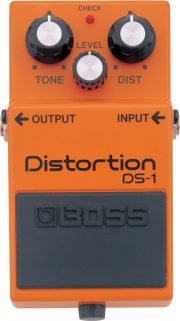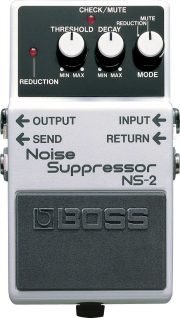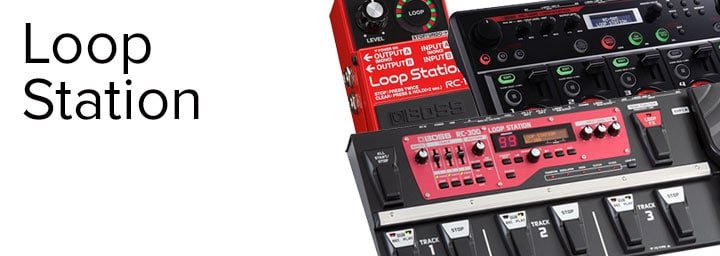So you’ve just bought an electric guitar and an amp of some sort. Now you’re thinking, those colourful stompbox things look pretty cool – but I have no idea what exactly they do…
Boy have you come to the right place! BOSS have been pioneers and innovators in the field of compact effects pedals since 1977. If there’s a type of effects pedal, we almost certainly make one (or two, or eight).
We’re going to give you a basic rundown of what each type of effect does and what it sounds like – from vibrato to vocoder, and chorus to crunchy distortion.
But rather than just throwing a big long list at you, let’s start with:
YOUR FIRST 5 GUITAR PEDALS
These are the essentials. Before you start delving into whacky, crazy effects, you should make sure that you’ve nailed the foundation of your tone.
1. TUNER
2. OVERDRIVE
Here we go, we’re getting into the fun stuff now.
First, let’s talk about what “overdrive” means. Electric guitar music is full of the searing, stinging, crunching sounds of tube amplifiers being driven beyond their limits. In the early days of guitar amps, they were designed pretty much just for clean tones. But guitarists soon found out that if they turned the amps up – WAY up – beyond their original design limits, the valves got “overloaded” and would start to “clip” or overdrive. The resulting tone was something completely new and different.
As you can imagine, this can be difficult to achieve at a reasonable volume. This is where overdrive pedals come in. Overdrive pedals emulate the break-up of cranked tube amps, but in the easy, controllable form of a compact pedal.
BOSS have a huge range of overdrive pedals for any conceivable style. Let’s go through a couple of staples.

The Super Overdrive is a true classic, remaining essentially unchanged in spec since its release in 1981.
It sits on the “British” side of the drive spectrum, giving you the warm, crunchy sounds reminiscent of full stack amplifiers.
There are two classic ways to use an overdrive pedal like the Super Overdrive. First, run it into a clean amp sound with the Drive control set to emulate the sound of an amplifier on the edge of breakup, yielding creamy blues tones all the way up to crunchy classic rock.
Second, run it into an already cranked amp, with the Drive control set low but the Level HIGH! This will give your amp a sonic kick in the teeth into screaming high gain, while simultaneously tightening up the bass and giving it that little bit of extra magic.

3. DISTORTION / FUZZ

Distortion pedals pick up where overdrives leave off, bringing a world of hard-edged, chunky palm mutes and saturated, soaring lead sounds. For those who need full on metal saturation and grind, but don’t have the budget for a high gain monster amplifier, a distortion pedal is what you need.
When it comes to your first distortion pedal, you can’t go past the classic Metal Zone, one of the best selling BOSS compacts OF ALL TIME. The sound of an MT-2 is smooth, scooped, chugging high gain. Be wary though – the controls are extremely powerful, so make small incremental changes to the EQ settings and follow your ears! It works best into a clean amp platform.
Learn more about how to get the best from your Metal Zone here: https://rolandindonesia.com/metal-zone-youre-using-it-wrong

FUZZ
Fuzz is another cousin of the overdrive/distortion family. While drive/distortion pedals usually sound smoother, fuzz is typified by a much more gnarly, jagged sound.
The classic sound of 60s fuzz is the main riff to Satisfaction by The Rolling Stones.
And of course, a huge part of the Hendrix sound was running a fuzz into a big cranked stack.
Modern fuzz pedals like the FZ-5 can cover a wide range of fuzz sounds, from glitchy, mid honk fuzz to thick woolly walls of sound.
4. DELAY / REVERB
A delay pedal replicates the playing you feed into it, creating an echo effect. Short delay times or “slapback” are commonly used in country music while longer delay times can create cascading soundscapes and ambient textures.
A classic example of delay is the opening passages of Welcome To The Jungle, which features Slash’s guitar sound bouncing back at him over and over again.
In 1984, BOSS designed the FIRST ever digital delay in pedal form. Since then, the DD-3 has become a mainstay of artists all over the world – Tom Morello even has two on his pedalboard! Despite staying unchanged for the better part of 30 years (with no complaints), in 2019 we upgraded it with tap tempo functionality, resulting in the new DD-3T.
If you want more different sounds, you might step up to the DD-8, which emulates vintage analog or tape delay machines as well as incorporating shimmer (great for worship and U2) and +reverb modes.
Side note – what’s tap tempo?
Tap tempo means that you can use your foot to tap in the tempo or speed of the song, and the delay pedal will then adapt the internal time of the delay repeats to make sure they all fall in line. In basic terms, if you set up a delay so it repeats twice every beat, having tap tempo means that even if you speed up the song in real life, you can tap in the new speed with your foot, and still have your repeats going twice every beat!
REVERB
Reverberation, or reverb, is what you hear in an enclosed physical when sound bounces back to your ears off surfaces like walls and the ceiling. The amount of reverb that you hear relays to your brain the physical size of the space that the sound is occurring in – think about the difference between clapping your hands in a small room, compared to a cave, or a cathedral. A pedal like the RV-6 can take you from small room reflections to huge hall reverbs and much more, letting you conjure up huge ambient soundscapes!
5. CHORUS
Chorus pedals like the classic CH-1 split your signal into multiple “voices,” modulating their pitch and timbre, and delaying those voices slightly from the main signal. The result is a full and shimmery ensemble of “voices,” simulating the sound of multiple instruments playing the same part. Like singing with a chorus group!
ADD SOME FLAVOUR
Now that we’ve gone through your first 5 pedals to start out with as a beginner guitar player, let’s take a look at what else you might think of adding to your pedalboard to start building more sonic flavours and textures.
MODULATION
PHASER / FLANGER
Phaser and flanger effects operate on very similar underlying principles – take the original signal, delay it by very small amounts and mix it back with the dry signal. This creates a filtering effect, with the end result depending on how you control and process the time/mix of the delayed signal.
We’re not here to get into the technical details. The easiest way to differentiate between the two is to hear it for yourself.
A great example of flanging is the bridge section of Lenny Kravitz’s Are You Gonna Go My Way. You can hear the slightly metallic, jet-plane swoosh of the effect very clearly.
On the other hand, phaser has a smoother, more organic sound that is a bit more “chewy”. You can hear it in the tapping section of Van Halen’s Eruption, where it doesn’t sit completely on top of the notes but instead just helps to create some “movement” to the repeating notes.
Phasers can also yield a more “watery” sound, as often used by Mike Einziger of Incubus. In the song Pardon Me, he utilized a BOSS Super Phaser to create that swishing, watery sound, along with volume swells and delay to create an otherworldly atmospheric sound.
TREMOLO
Tremolo is a modulation effect that creates a change in volume, taking your guitar signal and pulsing it louder/softer continuously at the rate that you choose.
It can be used to achieve the choppy effect at the beginning of Green Day’s Boulevard of Broken Dreams:
Or you might rather have a more subtle, pulsating tremolo like Tom Morello used on the Audioslave song Like A Stone:
With the TR-2, you can choose either end of this spectrum, or a blend somewhere in between, using the waveform control.
VIBRATO
Vibrato operates on a similar concept to tremolo, except that instead of varying the volume of the note, this time we’re varying the pitch. This results in a “wobbly” sounding effect – watch out for setting the pitch variation range too wide, you might end up feeling sea-sick!DYNAMICS AND PITCH
COMPRESSOR
A dynamic effect that smooths out the highest and lowest volume levels of your guitar signal to a more consistent level. In short, it brings out the quiet parts, and softens down the loud parts. Commonly used in country music to bring out the attack of chicken picking, or in funk music to even out the attack of fast funky strumming. Or you can use it to smooth out your lead sound for great legato playing.Compressors usually have an attack knob that allows you to control how fast it takes the compressor to start affecting the tone and a threshold knob that sets the volume level that the compressor starts clamping down on peaks.
WAH
A wah pedal boosts a narrow range of frequencies, and then using the foot pedal, lets you sweep through the frequency center of this boost to create a vocal “wah” sound. It can be heard on the Jimi Hendrix classic Voodoo Child, as well as almost every Metallica song.HARMONISER
A frequency-based effect that sounds like a second guitarist is playing in harmony with the original guitar signal. The effect is created by doubling the guitar input signal and then shifting the pitch of the double up or down at a certain interval (usually a 3rd, 5th or octave). The harmony effect is often used in the metal and hard rock genre to play solos. Here’s our PS-6 in action:OCTAVE
Another frequency-based effect that takes the input of your guitar tone and shifts it in pitch anywhere up to an octave above or below. This is useful to simulate a bass guitar line or the higher pitched strings of a twelve-string guitar. Check out the OC-3 here:WEIRD AND WONDERFUL
ACOUSTIC SIMULATOR
A modelling effect that makes your electric guitar sound like an acoustic guitar. The AC-3 can even emulate different types of acoustic guitar sounds from big strident Jumbo strumming to the familiar “direct” sound of a piezo-equipped acoustic. It’s ready with a direct Line Out along with the standard guitar amp output so that you can send your crisp acoustic sound straight to the PA if you want.VOCODER
A vocoder is the sound of the 2Pac classic California Love. That’s the easiest way to explain it.This is usually an effect reserved for keys/synth players, but now you too can make robot speech noises on your guitar! Essentially, it takes your vocal input (speech patterns from a microphone), and changes the pitch based on your instrument input (your guitar). Just plug your guitar and mic into the VO-1 and Daft Punk the night away.
Not to mention, the VO-1 can also do a mean talkbox (translation: you can play the intro to Living On A Prayer without buying an actual talkbox pedal or having to put a rubber tube in your mouth).
SYNTHESIZER
Synth pedals allow guitarists to unlock all the tones that were previously reserved only for keyboard players – from ethereal pads to jaunty organ stabs to screaming synth leads, the SY-1 can do it all. With 11 families of sounds, each with 11 variations, that’s 121 different sounds and hours (days, months) of fun!UTILITY PEDALS
VOLUME PEDAL

The name is self-explanatory! Basically does the same thing as the volume knob on your guitar does, but on the floor. So why do you need one? Well, it’s easier to play with your two hands and do ambient violin-style volume swells with your foot than to develop a third hand!
A volume pedal can also function like a solo boost if you put it at the end of your pedal chain. Have it at about 80% volume most of the time, then a quick nudge of the foot to get maximum volume when your solo arrives.
If you’ve got size 12 feet, go for the FV-500, otherwise the FV-30 is a good idea for space saving, and the FV-50 will save both space AND weight.
EQ PEDAL

EQ stands for “equalisation”. The audio frequencies that we hear around us sit across a wide spectrum, of which the human ear can hear between 20Hz to 20kHz. In the most basic terms, an EQ pedal allows you to cut (decrease) or boost (increase) the frequencies. They act in a similar way to the Treble/Mids/Bass controls on your amp, but with much more control within specific frequency ranges, rather than the much wider band controls on your amp.
Used correctly, an EQ pedal like the GE-7 or EQ-200 can be one of THE most important secret weapons in your tonal arsenal. Read more about EQ pedals here: https://rolandindonesia.com/4-reasons-why-you-need-an-eq-pedal
NOISE GATE

Many guitar players who play at high volume with high gain find themselves in an ongoing battle with noise, hum or unwelcome feedback. This is where a noise gate comes in.
A noise gate or noise suppressor can be used on two levels. First, used early in the signal chain to stifle playing noise (e.g. stop-start staccato playing that you want to be as tight as possible). Second, used in the effects loop of your amp to reduce high gain hiss.
The NS-2 can do both! Learn more about how to use noise suppressors here: https://rolandindonesia.com/how-to-use-boss-ns-2-noise-suppressor-in-your-rig
LOOPERS
Looping is a technique that allows you to record a snippet of what you’re playing to form a repetitive loop, or “phrase” in real-time. What you do next with this phrase is up to you! Use it as a backing track, as a rhythmic/percussive effect, as a soundscape… the options are limitless. It’s been used to great effect by amazing artists such as Ed Sheeran (shown below using an RC-30), Tash Sultana and many more.
The real power of looping comes from “overdubbing”. This is the process of recording over the previously recorded phrase. It’s similar to the same way you would overdub vocals when recording a song. Adding overdubs gives depth to your phrase and takes your looping to the next level.
Some loopers like the RC-10R even have on-board drum tracks to bring some groove to your looping! https://rolandindonesia.com/4-ways-the-boss-rc-10r-can-inspire-creativity





